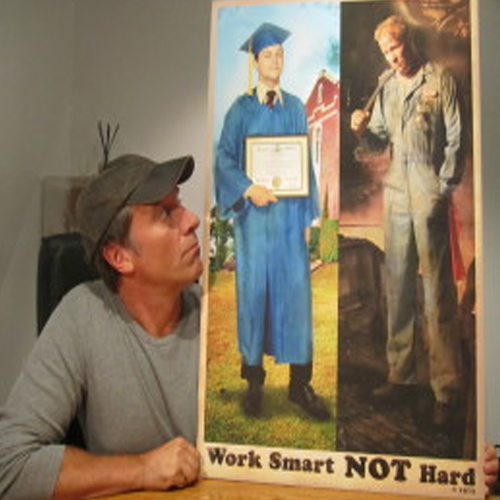Below are helpful tips for home repair…working with, or without, a professional. Also, I included tips for finding a great contractor, when you are ready to call in a pro.
As a plumbing industry expert, I write a monthly column for Plumbing Heating Contractor News – These tips appeared in one of my columns, aimed at contractors, encouraging them to embrace homeowners who want to D.I.Y. – “do it yourself!” There is a time and place for the homeowner repair! And, note that an ounce of prevention is worth a pound of cure…especially when it comes to plumbing.
 D.I.Y. or D.U.M.B.? – Home Repair Tips from The Plumber’s Wife
D.I.Y. or D.U.M.B.? – Home Repair Tips from The Plumber’s Wife
As a service professional, is it ever OK to recommend that your customers D.I.Y.? What can they do…and what should they never do…when it comes to home repair? Sometimes a botched D.I.Y. job can lead to additional, more costly repairs. Sometimes the problem stems from a professional job, done poorly. It is a testament to plumbing and heating pros that the systems– properly installed – work as well and as long as they do. However, ultimately, even rock gives way to the power of moving water (See: Grand Canyon.) Wear,water, weather, neglect and abuse are all reasons that somebody – the homeowner or a professional tradesperson – is going to have to fix or replace every mechanical home component by and by. As a Plumber’s wife, I have been hearing job stories for 30 years. As an industry expert and business consultant, I’ve had the opportunity to visit hundreds of PHC shops. Often, I put on the company uniform and Ride Along with the Plumber or Heating Professional. I’ve learned a lot about service and repair work.
Here are my homeowner tips to share with your customer…
Start with prevention…
Don’t flush the wrong stuff. My husband, Hot Rod the Plumber, has an old camera that he fished out of a toilet. (Surprisingly, the customer didn’t want it, but asked for the film to be removed!) My contractor clients have found disposable diapers (um, those are supposed to be trashed, not flushed) GI Joes and whole stalks of raw broccoli (?) in toilets. Children require supervision, and basic plumbing system and safety instruction. Once, when I was 11 years old, my girlfriend and I crafted homemade candles and poured the leftover wax down the drain. Ugh! Toilet locks are a good idea for homes with kids aged 3 and under. Check out Safe Kids Safety Tips. (Note, however, it wasn’t a toddler who flushed the diaper or the camera!)
Don’t use those over the counter drain cleaning chemicals! They are noxious and caustic and dangerous. You don’t even need to read the mile-long warnings on the label. You know that these powerful chemicals can harm you and your kids. Here are emergency first aid instructions if you need convincing. These chemicals are also problematic for the pipes and wreak havoc on the water supply.
Go ahead and DIY…
If you want to keep up on basic home maintenance, it’s a good idea to educate yourself about your equipment. Plan to be home when new systems and components are installed, so you can communicate with the contractor who does the work. Learn how the system functions. Ask what you can do to keep it operating at peak performance.
Many service calls can be avoided by addressing a few simple things yourself. You may try un-jamming your sink garbage disposal with the provided allen wrench. Follow manufacturer’s instructions. And, again, watch what you are putting in the disposal in the first place! It’s not a good idea to put the potato peelings from 6 potatoes in the disposal all at once. Yep, I did that, too, on my 15th wedding anniversary. So, how did Hot Rod, my husband the Plumber, and I spend that romantic evening? Replacing the garbage disposal and mopping up the kitchen. (You know, it should be called a small-veggie- scraps-chopperupper, not a garbage disposal.)
Regularly replace your furnace and air-conditioning filters. Don’t go for the filters that snag every molecule of dust. Those thick layers restrict airflow and cause the motors and other components to work too hard, and break down sooner. Use the recommended filters and change them often. Note that if your house is super dusty, you may have a leaky house. Instead of struggling to filter the inside air, you could prevent dust entering the house in the first place. Consider a whole house energy audit – use a pro for this, and ask about utility company rebates. Discuss the results together and determine which small items on the recommended list you could tackle yourself. Regular cleanings are good for your humidifier, or de-humidifier. And, you could change your water filter cartridge without losing life or limb. The manuals are probably available online for your brand, if you lost the originals. And there are great instructional videos on YouTube.
Learn how to use your programmable thermostat. Modern thermostats are a key element of high efficiency equipment. They can be set to ramp up and down based on when you are going to be around. Alas, so many people failed to use these thermostats properly that Energy Star organization revoked the label. The best ones now available are digital and connect wirelessly to the internet and can be managed from anywhere via your smart phone. You may need a kid or digitally savvy friend to help you program it, if the technology intimidates you. Worth the small effort in terms of money and energy savings.
Call in the Pro…
Before you D.I.Y., consider these questions: Do you really want to do it? Does the work at hand intrigue and excite you? Do you want to do it yourself just to prove that you can? Because it seems challenging, and looks like fun? Could you save some money on a low-risk repair? If so…go for it! Study up on it first. And tread lightly when it comes to venting, gas, water, electricity, sewage…or some combination.
On the other hand, does it make sense from a fiscal standpoint to D.I.Y.? When you don’t have the parts or the tools or the knowhow, you could spend a whole weekend doing a job that a pro could do in a snap.
Just because you could, doesn’t mean you have to. And, are you sure that you aren’t going to create an even bigger problem? From my experience, I have learned that the pros only make it look easy. One of the things I love about my husband the Plumber is his mastery of the physical world. He has the tools, education, experience and passion to identify and fix – or replace – broken things. I would rather garden. Or read. Or watch movie. Or workout. Or stick a needle in my eye before I would do any kind of home repair myself.
So, if you are ready to call in a professional contractor, here’s what to look for:
- Testimonials. When you search online, look for testimonials from happy customers. Real people with first and last names and a picture. If your neighbor has had work done, ask about their experiences. Read the yelp.com and Angie’s list reviews. One or two nasty comments are dismissible if there are dozens of five-star raving fan reports.
- Cleanliness. From the truck to the uniform to the shoes to the tool bag…clean is always good and dirty is always bad.
- Sobriety. Do they drug test? Background check? Ask. Extra points if the company emails you a photo of the technician who has been assigned to your home. I like ID badges, too.
- Punctuality. If you have to waste your time waiting for a no-call, no-show contractor, you are paying twice for poor service.
- Evidence of Training and Standards. I light up when I see checklists, menus, and procedures. Pilots and doctors use checklists. So should Plumbers, HVAC pros and Electricians.
- Good Manners. From the customer service representative to the dispatcher to the service pro who shows up at your home, expect polite and friendly service.
- Up Front Pricing. No matter how low the hourly rate is, with time and material pricing, you pay more for inefficiency. And it is stressful not to know how much it’s going to cost until the work is done. On little jobs as well as big jobs, agree to the scope of work and price before your contractor gets started.
Happy to help!
Ellen Rohr – The Plumber’s Wife




